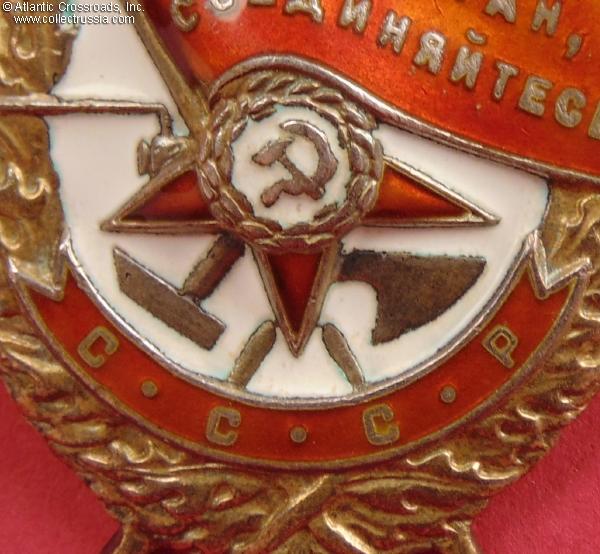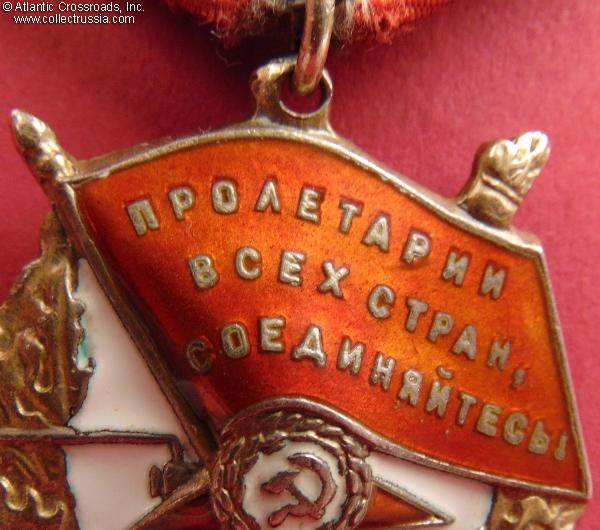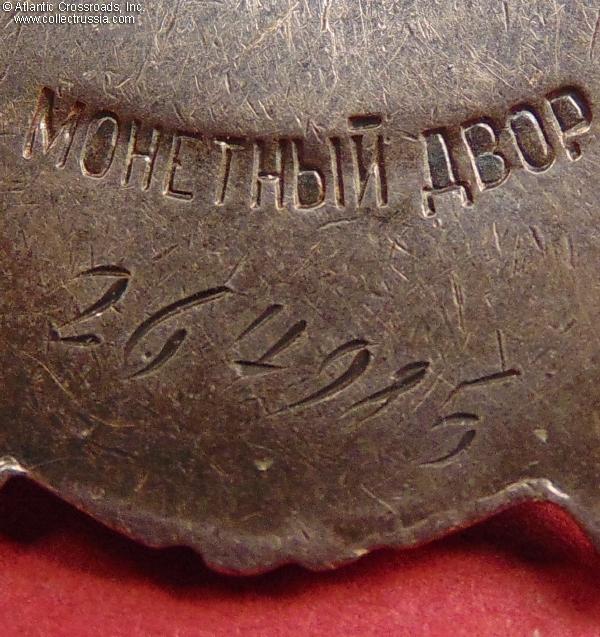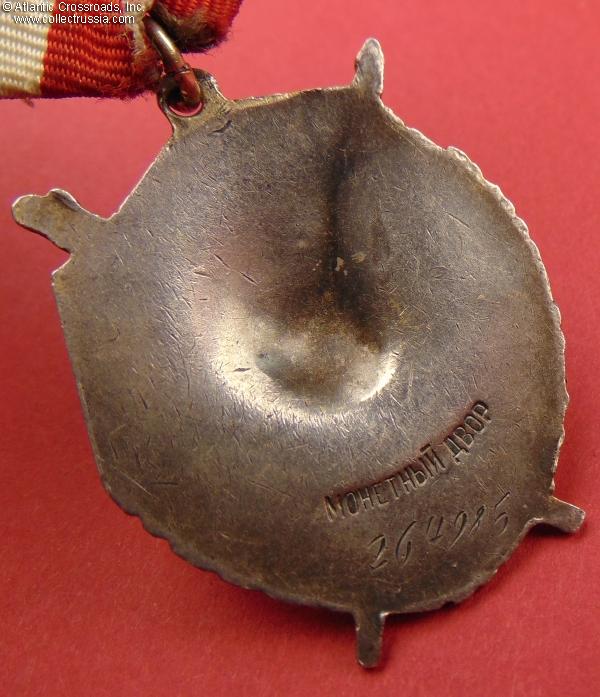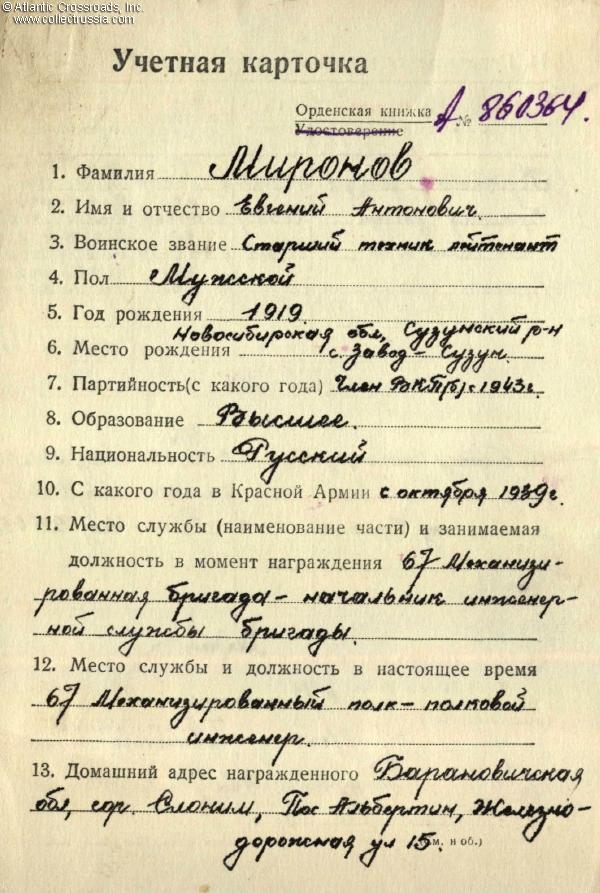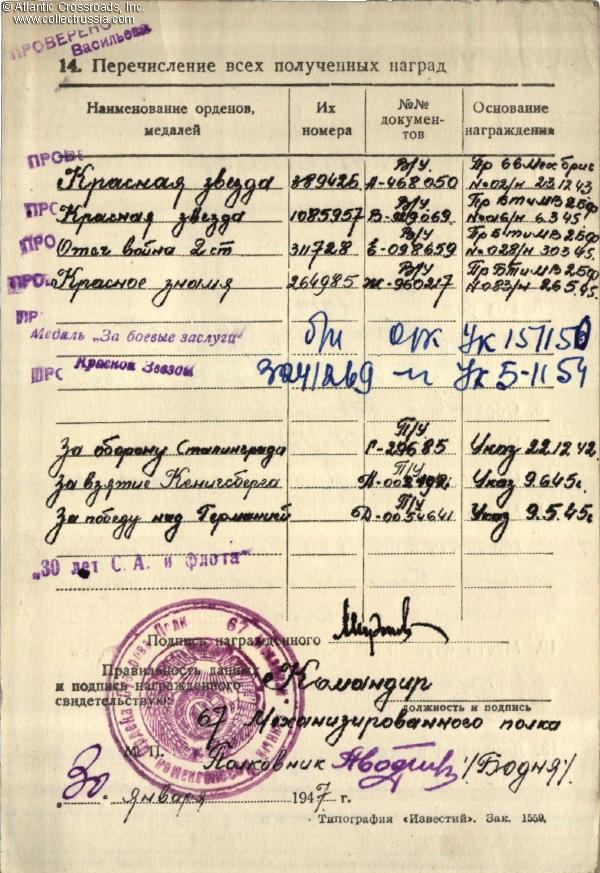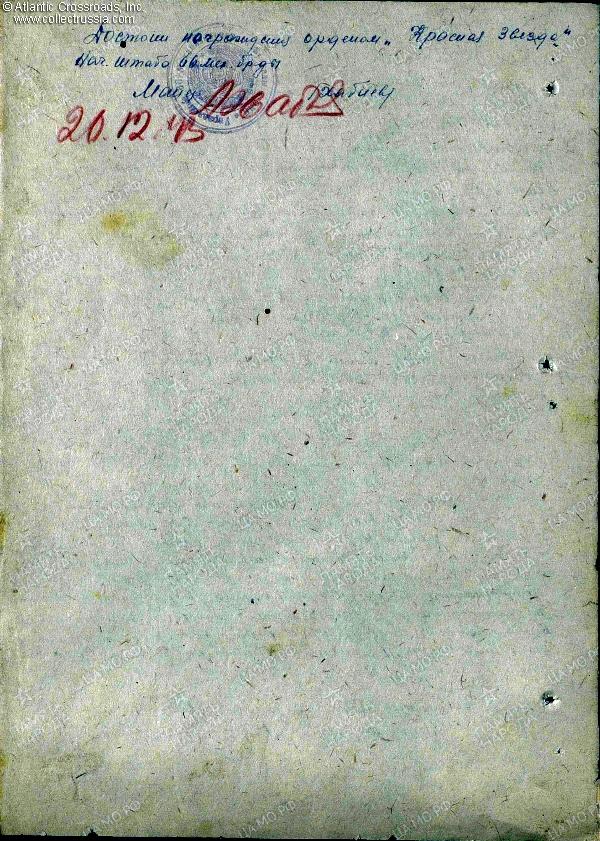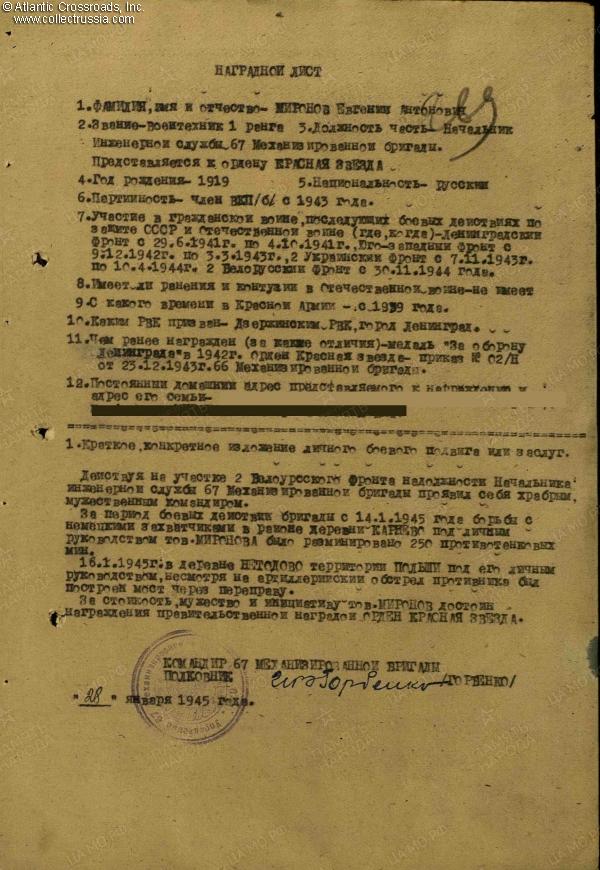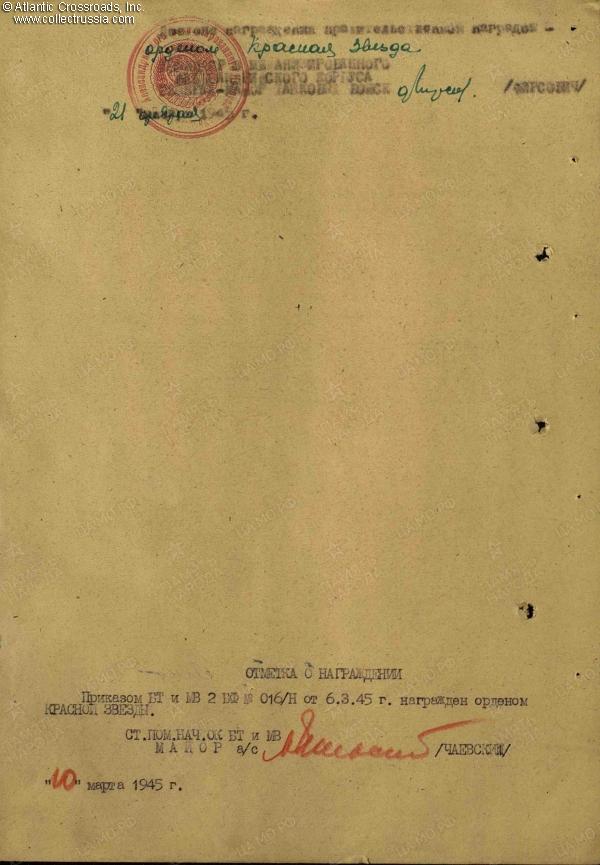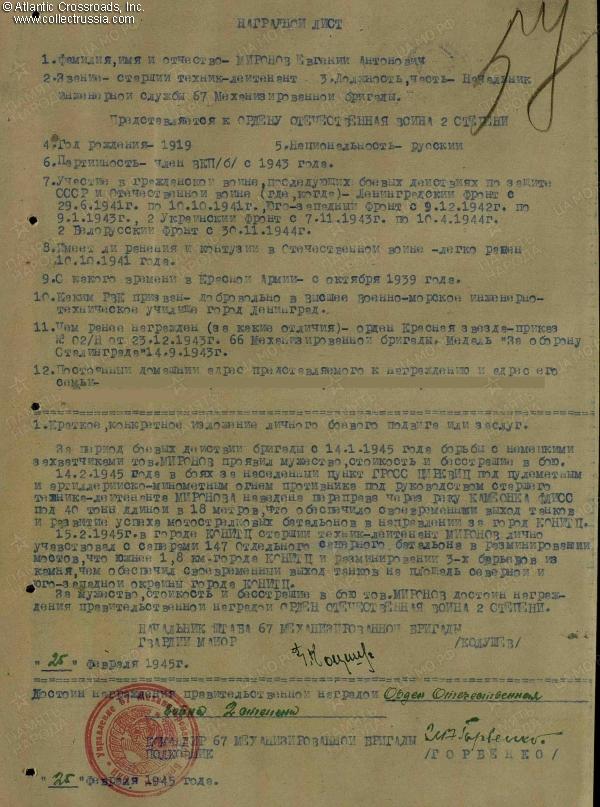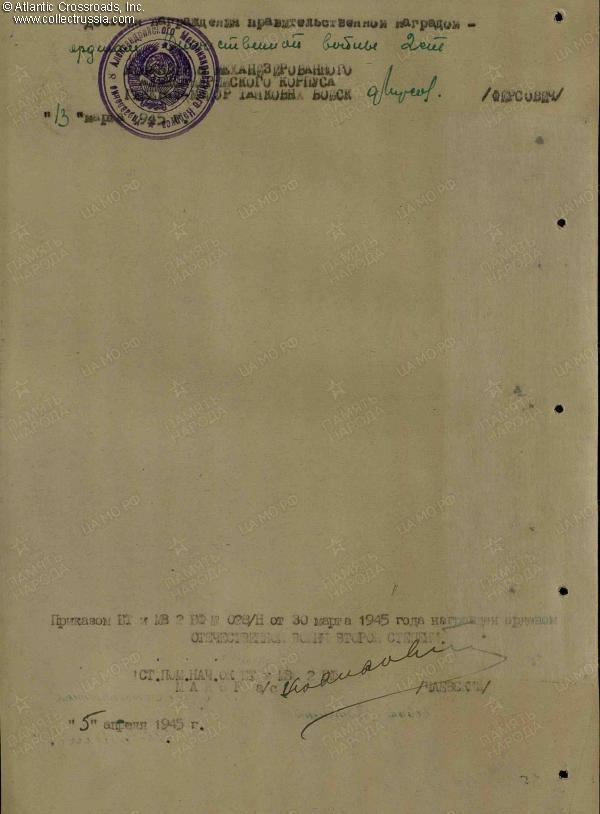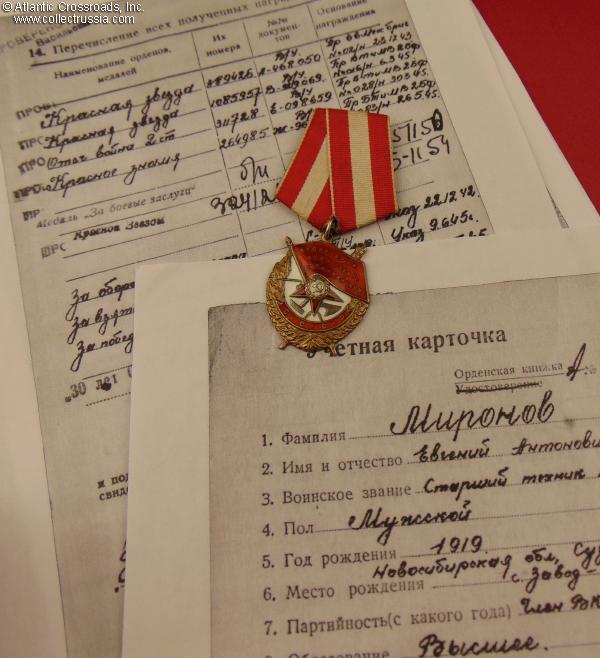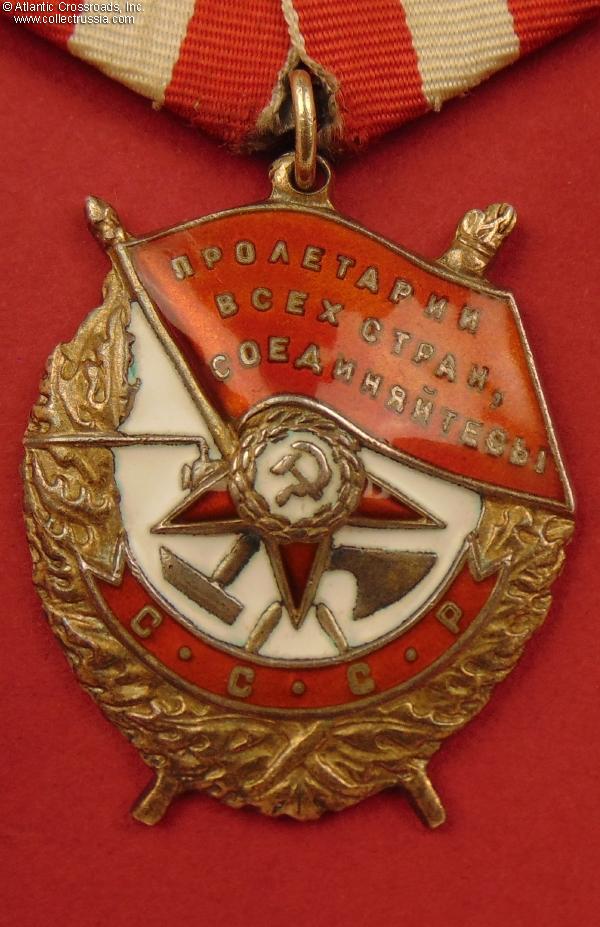
Order of the Red Banner, Type 4, Variation 2, Sub-variation 3 (Strekalov classification), #264985, awarded on 26 May 1945 to Senior Lieutenant Yevgeniy Mironov (Евгений Антонович Миронов), Chief Engineer in the 67th Mechanized Brigade, 8th Mechanized Corps, 2nd Belorussian Front.
Silver gilt, enamels; measures 45.5 mm in height (incl. eyelet and lower projections of the torch and flagpole), 36.9 mm in width; weighs 24.1 g not including the suspension and connecting link. Features smooth reverse with circular depression in the middle. The mint mark is in relatively large font and has a straight dash over the last character in the word "Monetnyi" (Type 3, Var. 2 according to McDaniel classification). The Order of the Red Banner by Durov and Strekalov shows that it was manufactured by the Moscow Mint in 1945.
In outstanding, excellent condition. The
Silver gilt, enamels; measures 45.5 mm in height (incl. eyelet and lower projections of the torch and flagpole), 36.9 mm in width; weighs 24.1 g not including the suspension and connecting link. Features smooth reverse with circular depression in the middle. The mint mark is in relatively large font and has a straight dash over the last character in the word "Monetnyi" (Type 3, Var. 2 according to McDaniel classification). The Order of the Red Banner by Durov and Strekalov shows that it was manufactured by the Moscow Mint in 1945.
In outstanding, excellent condition. The enamel is essentially perfect, having only a few microscopic contact marks that can be found under a 10x magnification but completely invisible to the naked eye; there is no flaking or any other significant wear. The details of the wreath are beautifully crisp and likewise free of visible wear; the gilt finish is exceptionally well-preserved and bright throughout. There is a very attractive even patina to the reverse.
The order comes on an original suspension, a WW2 two-layer model in steel with a self-locking pin. The ribbon is old but perfectly preserved and clean. The connecting link appears to be original as well; its ends are still joined with solder. Overall, a truly superb example of a WW2 Order of the Red Banner!
Yevgeniy Mironov was born in 1919 in a village in Novosibirsk Region in western Siberia. At the age of 20 he was admitted to the Naval Engineering School in Leningrad. After the beginning of the Patriotic War, he spent a few months with the Leningrad Front. In 1942-43, he served under the Southwestern Front and participated in the Battle of Stalingrad. As of December 1943, he was a company commander of the 66th Mechanized Brigade, 8th Mechanized Corps, 2nd Ukrainian Front (formerly Steppe Front). In this capacity, he took part in the offensive expanding the Soviet gains on the western bank of the Dnieper and aiming for the key industrial city of Krivoy Rog, On 17 December, Mironov's company was counterattacked by six enemy tanks supported by motorized infantry near the village of Novogrigoryevka between Kirovograd and Krivoy Rog. Skillfully commanding his men, Mironov repelled the attack, destroying three tanks and about 30 infantrymen. His bravery and excellent leadership in this battle earned him his first Order of the Red Star, which was awarded on 23 December 1943.
Mironov earned his second Order of the Red Star in January 1945 as Chief Engineer of the 67th Mechanized Brigade, 8th Mechanized Corps, 2nd Belorussian Front. In the course of just three days, from 14-16 January 1945, Mironov's combat engineers disarmed 250 antitank mines near the village of Karniewo to the north of Warsaw and under heavy enemy fire built a temporary bridge across the Kamionka River. The order was bestowed upon him on 6 March 1945.
In the middle of February 1945, Mironov's 67th Mechanized Brigade took part in fighting near the village of Gross Zirkwitz (present-day Duza Cerkwica, Poland). On 14 February, braving heavy artillery, mortar and machine gun fire, Mironov's engineers succeeded in building a nearly 60-foot-long bridge capable of holding 40 tons of load. The next day Mironov personally led a battalion of combat engineers in de-mining several bridges and stone barriers, thus enabling the brigade's tanks to advance. For these actions, Mironov was recommended by the brigade commander for the Order of the Patriotic War 2nd cl. He received the award on 30 March 1945.
In early March 1945, the 8th Mechanized Corps acted as a spearhead of the 2nd Belorussian Front in the Eastern Pomerania offensive that delivered a shattering blow to the Army Group Vistula under Reichsfuhrer-SS Heinrich Himmler's command. Following a bitter battle for the railway juncture of Butow (Bytow) in which the it supported the 70th Army, the corps and its 67th Mechanized Brigade continued west along the Baltic seashore towards Danzig (now Gdansk, the dispute over the control of this city was the pretext for the Germany's invasion of Poland six years earlier). Subordinated to the 65h Army on 13 March, the corps swung west of Danzig to the town of Kosowo and struck east towards the village of Bissau (now Bysewo, Poland) where the Germans had entrenched on hilltop positions. By 15 March, it engaged in heavy fighting in the area of villages of Ramkau (now Rebiechowo) and what is referred to in Russian sources as Tsapeln (Zapeln [?], possibly the modern-day Czaple few miles west of Danzig). On 18 March, the brigade's combat engineers under Mironov's command in 55 minutes erected a temporary bridge near "Tsapeln" under heavy artillery and mortar fire, enabling the tanks and personnel of the brigade to continue their advance toward Danzig.
For Mironov's decisive and fearless actions, commander of the 67th Mechanized Brigade Col. Gorbenko recommended him for the Order of the Red Banner. The order was bestowed upon him on 26 May 1945. It is worth noting that the 8th Mechanized Corps was also awarded with the Order of the Red Banner for its performance in the storming of Danzig. Perhaps coincidentally, on 20 March, just two days after the events described in the Mironov's commendation, Himmler was sacked from his position of the Army Group Vistula Commander for his ineptitude as a field commander.
Research Materials: b/w photocopy of the award record card, award commendations for all four wartime high decorations and Mironov's military archival photo.
$750.00 Add to cart


